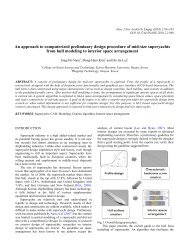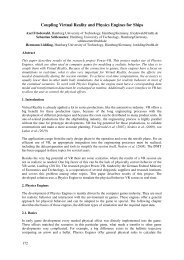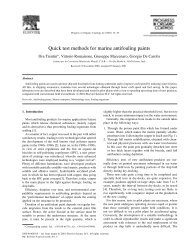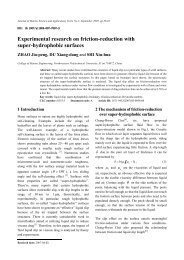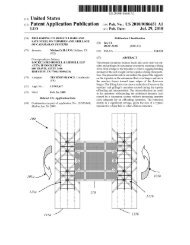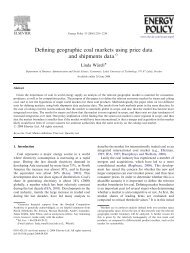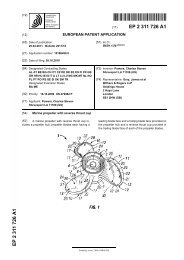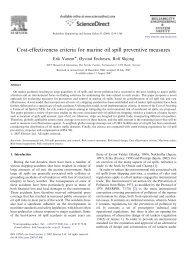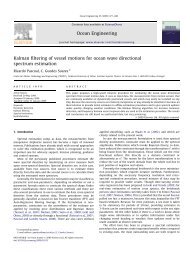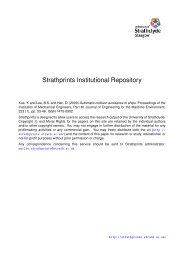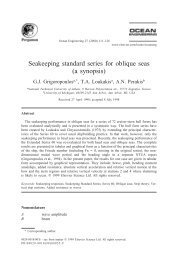coating conditions in water ballast tank, void space and cargo oil ...
coating conditions in water ballast tank, void space and cargo oil ...
coating conditions in water ballast tank, void space and cargo oil ...
Create successful ePaper yourself
Turn your PDF publications into a flip-book with our unique Google optimized e-Paper software.
Shipbuild<strong>in</strong>g Technology ISST 2007, Osaka, 2007<br />
COATING CONDITIONS IN WATER BALLAST TANK, VOID SPACE AND CARGO OIL<br />
TANK OF AGED SHIPS AND REQUIRED PERFORMANCE STANDARD OF<br />
PROTECTIVE COATINGS FOR NEW SHIPS<br />
Takanobu Murakami, Sh<strong>in</strong> Kurushima Dockyard Co., Ltd.<br />
Takayuki Sasaki, IHI Mar<strong>in</strong>e United Inc.<br />
Masahiro Kuwajima, Mitsui Eng<strong>in</strong>eer<strong>in</strong>g & Shipbuild<strong>in</strong>g Co., Ltd.<br />
Masanobu Koori, Mitsubishi Heavy Industries, Ltd.<br />
SUMMARY<br />
PSPC (Performance St<strong>and</strong>ard for Protective Coat<strong>in</strong>gs) for <strong>water</strong> <strong>ballast</strong> <strong>tank</strong>s <strong>and</strong> double hull <strong>space</strong>s of bulk carrier was<br />
adopted at MSC82 as resolution MSC.215(82) <strong>in</strong> last December, <strong>and</strong> protective <strong>coat<strong>in</strong>g</strong>s for <strong>void</strong> <strong>space</strong>s was discussed<br />
at DE50 <strong>in</strong> March this year. Furthermore, protective <strong>coat<strong>in</strong>g</strong>s for <strong>cargo</strong> <strong>oil</strong> <strong>tank</strong>s have been discussed at JWG (Jo<strong>in</strong>t<br />
Work<strong>in</strong>g Group) of IACS, <strong>and</strong> the proposal of JWG will be submitted to IMO.<br />
We, members of SAJ (the Shipbuilders’ Association of Japan) participated <strong>in</strong> all discussions <strong>and</strong> <strong>in</strong>troduced the actual<br />
situation of ship’s <strong>coat<strong>in</strong>g</strong> through the results of several <strong>in</strong>vestigations.<br />
In this paper, we would <strong>in</strong>troduce the <strong>coat<strong>in</strong>g</strong> <strong>conditions</strong> of the ships aged more than 10 years <strong>in</strong> <strong>water</strong> <strong>ballast</strong> <strong>tank</strong>s, <strong>void</strong><br />
<strong>space</strong>s <strong>and</strong> <strong>cargo</strong> <strong>oil</strong> <strong>tank</strong>s with some photos, <strong>and</strong> express our considerations regard<strong>in</strong>g the relation between <strong>tank</strong> <strong>coat<strong>in</strong>g</strong><br />
at new build<strong>in</strong>g stage <strong>and</strong> the <strong>coat<strong>in</strong>g</strong> <strong>conditions</strong> of aged ships.<br />
1. INTRODUCTION<br />
In these couple of years, <strong>coat<strong>in</strong>g</strong> st<strong>and</strong>ard <strong>in</strong>clud<strong>in</strong>g<br />
surface preparation <strong>and</strong> <strong>coat<strong>in</strong>g</strong> application has been<br />
discussed for the purpose of enhanc<strong>in</strong>g the safety of ships.<br />
It has been exp<strong>and</strong><strong>in</strong>g from double hull <strong>space</strong> of bulk<br />
carrier to <strong>water</strong> <strong>ballast</strong> <strong>tank</strong>s <strong>and</strong> <strong>void</strong> <strong>space</strong>s of all k<strong>in</strong>ds<br />
of ships, <strong>and</strong> further to <strong>cargo</strong> <strong>tank</strong>s of <strong>oil</strong> <strong>tank</strong>ers.<br />
Discussion <strong>in</strong> IMO on the <strong>coat<strong>in</strong>g</strong> st<strong>and</strong>ard for <strong>water</strong><br />
<strong>ballast</strong> <strong>tank</strong>s was started based on TSCF15 (15 years<br />
specification issued by Tanker Structure Co-operative<br />
Forum). Dur<strong>in</strong>g the discussions at IMO meet<strong>in</strong>gs <strong>and</strong> <strong>in</strong><br />
correspond<strong>in</strong>g group, we have repeatedly express our<br />
view on the effectiveness <strong>and</strong> practicability of the<br />
st<strong>and</strong>ard.<br />
With regard to the expansion of the st<strong>and</strong>ard to <strong>void</strong><br />
<strong>space</strong>s <strong>and</strong> <strong>cargo</strong> <strong>oil</strong> <strong>tank</strong>s, NMRI (National Maritime<br />
Research Institute) <strong>and</strong> SAJ carried out the <strong>in</strong>spection of<br />
ships to clarify the actual <strong>coat<strong>in</strong>g</strong> <strong>conditions</strong> of aged<br />
ships <strong>in</strong> order to know the necessary specification <strong>and</strong><br />
application of <strong>coat<strong>in</strong>g</strong> for 15 years target life.<br />
In this connection, we would show our considerations on<br />
the necessary st<strong>and</strong>ard for each <strong>space</strong>s of ship, i.e. <strong>ballast</strong><br />
<strong>water</strong> <strong>tank</strong>s, <strong>void</strong> <strong>space</strong>s <strong>and</strong> <strong>cargo</strong> <strong>oil</strong> <strong>tank</strong>s.<br />
2. NEW REGULATIONS FOR PAINTING<br />
2.1 WATER BALLAST TANKS<br />
As for <strong>water</strong> <strong>ballast</strong> <strong>tank</strong>s, new regulation was adopted as<br />
resolution MSC.215(82) <strong>in</strong> last December.<br />
© 2007: JASNAOE-RINA 51<br />
The summary of the resolution is as follows;<br />
a) The resolution shall apply to ships of not less than 500<br />
gross tonnage:<br />
for which the build<strong>in</strong>g contract is placed on or after 1<br />
July 2008; or<br />
<strong>in</strong> the absence of a build<strong>in</strong>g contract, the keels of<br />
which are laid or which are at a similar stage of<br />
construction on or after 1 January 2009; or<br />
the delivery of which is on or 1 July 2012.<br />
b) The resolution shall apply to all dedicated sea<strong>water</strong><br />
<strong>ballast</strong> <strong>tank</strong>s arranged <strong>in</strong> ships <strong>and</strong> double side sk<strong>in</strong><br />
<strong>space</strong>s arranged <strong>in</strong> bulk carriers of 150 m <strong>in</strong> length<br />
<strong>and</strong> upwards.<br />
c) CTF (Coat<strong>in</strong>g Technical File) shall be kept on board.<br />
d) Inspection work shall be done by qualified <strong>in</strong>spectors<br />
certified to FROSIO LevelⅢ or NACE Level 2 or<br />
equivalent.<br />
e) Epoxy type multi-coat system with stripe coats shall<br />
be applied.<br />
f) Coat<strong>in</strong>g system shall pass pre-qualification test.<br />
g) NDFT (nom<strong>in</strong>al dry film thickness) of 320μm with<br />
90/10 rule shall be applied.<br />
h) Free edges shall be treated to rounded radius of 2 mm,<br />
or by three pass gr<strong>in</strong>d<strong>in</strong>g or equivalent process.<br />
i) Damaged shop primer <strong>and</strong> welds shall be blasted to Sa<br />
2 1 /2.<br />
j) After erection, butts shall be treated to St 3 or better or<br />
Sa 2 where practicable. Small damages up to 2% of<br />
total area shall be treated to St 3, <strong>and</strong> contiguous<br />
damages over 25 m 2 or over 2% of the total area of the<br />
<strong>tank</strong> shall be treated to Sa 2 1 /2 respectively.<br />
k) Requirements of surface cleanl<strong>in</strong>ess such as <strong>oil</strong><br />
contam<strong>in</strong>ation, dust, <strong>water</strong> soluble salts are prescribed
Shipbuild<strong>in</strong>g Technology ISST 2007, Osaka, 2007<br />
Guidel<strong>in</strong>e for implementation of MSC.215(82) is be<strong>in</strong>g<br />
discussed <strong>in</strong> IACS/JWG for practical <strong>and</strong> consistent<br />
application.<br />
2.2 VOID SPACES<br />
PSPC for <strong>void</strong> <strong>space</strong> was discussed at DE50 <strong>in</strong> March<br />
this year. As the output of DE50, the draft resolution will<br />
be submitted to MSC83. While the meet<strong>in</strong>g <strong>in</strong> DE50, we<br />
proposed the practical st<strong>and</strong>ard based on the <strong>in</strong>spection<br />
results for <strong>void</strong> <strong>space</strong>s of aged ships.<br />
The summary of the draft resolution is as follows;<br />
a) The draft resolution shall apply to bulk carriers <strong>and</strong><br />
<strong>oil</strong> <strong>tank</strong>ers as recommendation basis until the SOLAS<br />
amendments to make it m<strong>and</strong>atory will be adopted.<br />
b) Def<strong>in</strong>ition of <strong>void</strong> <strong>space</strong>s is clarified.<br />
c) Epoxy based pa<strong>in</strong>t <strong>and</strong> NDFT of 200μm with 90/10<br />
rule shall be applied.<br />
d) Free Edges shall be treated by one pass gr<strong>in</strong>d<strong>in</strong>g or<br />
equivalent.<br />
e) Damaged shop primer shall be treated to Sa 2 or St 3.<br />
f) After erection, butts shall be treated to St 3 or better<br />
or Sa 2 where practicable.<br />
g) One stripe coat shall be applied to thermally cut free<br />
edges <strong>and</strong> small holes only.<br />
h) Requirements for dust quantity <strong>and</strong> soluble salts limit<br />
are relaxed compared with those for <strong>water</strong> <strong>ballast</strong><br />
<strong>tank</strong>s.<br />
2.3 CARGO OIL TANKS<br />
European countries <strong>and</strong> shipowners’ <strong>and</strong> <strong>oil</strong> companies’<br />
associations submitted their proposal of new SOLAS<br />
regulation to MSC82 which make PSPC for <strong>cargo</strong> <strong>oil</strong><br />
<strong>tank</strong>s m<strong>and</strong>atory. In this connection, Japan submitted the<br />
proposal of us<strong>in</strong>g corrosion resistance steel <strong>in</strong> the <strong>cargo</strong><br />
<strong>oil</strong> <strong>tank</strong>s as an alternative.<br />
DE50 <strong>in</strong>structed the correspondence group to develop the<br />
draft new SOLAS regulation regard<strong>in</strong>g <strong>cargo</strong> <strong>oil</strong> <strong>tank</strong><br />
protection for the discussion at DE51. The development<br />
of PSPC for <strong>cargo</strong> <strong>oil</strong> <strong>tank</strong>s will be further considered at<br />
DE51.<br />
3. REPORT ON THE COATING CONDITION<br />
OF ACTUAL SHIPS<br />
3.1 INSPECTED SHIPS<br />
In order to <strong>in</strong>vestigate appropriate <strong>coat<strong>in</strong>g</strong> st<strong>and</strong>ard, three<br />
(3) aged ships were <strong>in</strong>spected. Outl<strong>in</strong>e of the <strong>in</strong>spected<br />
ships are shown on Table 1.<br />
Table 1. Inspected ships<br />
Ship A Ship B Ship C<br />
Type of Ship Tanker<br />
Tanker<br />
Bulk Carrier<br />
(VLCC)<br />
(VLCC)<br />
(PANAMAX)<br />
Age of Ship 15 years old 12 years old 11 years old<br />
Shipyard Japanese Japanese Japanese<br />
Operator Japanese company Japanese company Japanese company<br />
Major Sea Route East Asia – Middle East East Asia – Middle East East Asia – Oceania<br />
© 2007: JASNAOE-RINA 52
Shipbuild<strong>in</strong>g Technology ISST 2007, Osaka, 2007<br />
3.2 WATER BALLAST TANKS<br />
3.2.1 COATING SPECIFICATIONS IN WATER<br />
BALLAST TANKS<br />
Coat<strong>in</strong>g specifications <strong>in</strong> <strong>water</strong> <strong>ballast</strong> <strong>tank</strong>s of <strong>in</strong>spected<br />
three (3) ships are shown on Table 2.<br />
Table 2. Coat<strong>in</strong>g Specifications <strong>in</strong> Water Ballast Tanks<br />
Ship A Ship B Ship C<br />
Type of Pa<strong>in</strong>t Tar Epoxy pa<strong>in</strong>t Tar Epoxy Pa<strong>in</strong>t Tar Epoxy pa<strong>in</strong>t<br />
Dry Film Thickness 200μm<br />
200μm<br />
220μm<br />
(1spray)<br />
(1spray)<br />
(1spray)<br />
Stripe coat Not applied Holes <strong>and</strong> narrow <strong>space</strong>s Not applied<br />
Primary surface preparation Sa2.5 (shot blast)<br />
Sa2.5 (shot blast) Sa2.5 (shot blast)<br />
IZP<br />
IZP<br />
IZP<br />
Steel Free edge Removed burrs 1 pass gr<strong>in</strong>d<strong>in</strong>g 1 pass gr<strong>in</strong>d<strong>in</strong>g<br />
condition Weld bead No treatment No treatment No treatment<br />
Surface treatment St 3 St 3 Sa2.5 (Partially St3)<br />
3.2.2 OVERVIEW IN THE WATER BALLAST<br />
TANKS<br />
Ship A)<br />
Photo-A-W-1<br />
Photo-A-W-2<br />
© 2007: JASNAOE-RINA 53<br />
Photo-A-W-3<br />
These photos show deck head areas under upper deck,<br />
<strong>and</strong> these areas are considered to be <strong>in</strong> severest condition<br />
for corrosion. There were some areas of which condition<br />
was worse than of these photos <strong>and</strong> deck plates of such<br />
areas had cut off for renewal work.
Shipbuild<strong>in</strong>g Technology ISST 2007, Osaka, 2007<br />
Ship B)<br />
Photo B-W-1<br />
Photo B-W-2<br />
Photo-B-W-3<br />
These photos show middle areas <strong>in</strong> height. Some rust<br />
was <strong>in</strong>itiated from edges, welds, small fitt<strong>in</strong>gs <strong>and</strong> small<br />
holes.<br />
© 2007: JASNAOE-RINA 54<br />
Deck head areas of this ship had already recoated at<br />
previous dock<strong>in</strong>g <strong>and</strong> kept good condition.<br />
Ship C)<br />
Photo C-W-1<br />
Photo C-W-2<br />
These photos show middle areas <strong>in</strong> height.<br />
Rust was <strong>in</strong>itiated from edges <strong>and</strong> welds <strong>and</strong> spread to<br />
surround<strong>in</strong>g.<br />
3.3 VOID SPACES<br />
3.3.1 COATING SPECIFICATIONS IN VOID<br />
SPACES<br />
Coat<strong>in</strong>g specifications <strong>in</strong> <strong>void</strong> <strong>space</strong>s of <strong>in</strong>spected three<br />
(3) ships are shown on Table 3.
Shipbuild<strong>in</strong>g Technology ISST 2007, Osaka, 2007<br />
Table 3. Coat<strong>in</strong>g Specifications <strong>in</strong> Void <strong>space</strong>s<br />
Ship A Ship B Ship C<br />
Coat<strong>in</strong>g type Alkyd based Tar epoxy Surface-tolerant epoxy<br />
Dry film thickness 70μm<br />
125μm<br />
100μm<br />
(2 spray)<br />
(1spray)<br />
(1spray)<br />
Stripe coat Not applied Not applied Not applied<br />
Primary surface treatment Sa 2.5 (Shot blast) Sa 2.5 (Shot blast) Sa 2.5 (Shot blast)<br />
IZP<br />
IZP<br />
IZP<br />
Steel Free edge No treatment No treatment No treatment<br />
condition Weld bead No treatment No treatment No treatment<br />
Weld spatter Loose spatter to be Loose spatter to be Loose spatter to be<br />
removed by scraper removed by scraper removed by scraper<br />
Surface Grade St 2<br />
Between St 2 <strong>and</strong> St 3 Loose rust to be brushed<br />
treatment<br />
(By disk s<strong>and</strong>er <strong>and</strong>/or (By disk s<strong>and</strong>er <strong>and</strong>/or<br />
off.<br />
power brush)<br />
power brush)<br />
Treated area Damaged shop primer, Damaged shop primer, Damaged shop primer,<br />
welds <strong>and</strong> rusted areas welds <strong>and</strong> rusted areas welds <strong>and</strong> rusted areas<br />
Water soluble salt Removed to the extent <strong>in</strong>visible to the naked eye.<br />
Oil contam<strong>in</strong>ation Removed. The traces may be visible.<br />
3.3.2 OVERVIEW IN THE VOID SPACES<br />
Ship A)<br />
Photo-A-V-1<br />
Photo-A-V-2<br />
© 2007: JASNAOE-RINA 55<br />
Photo-A-V-3<br />
Almost all areas were <strong>in</strong> quite good condition. Slight rust<br />
was found on the welds <strong>in</strong> Photo-A-V-2 <strong>and</strong> at the edge<br />
of manhole <strong>in</strong> Photo-A-V-3, but did not spread further.
Shipbuild<strong>in</strong>g Technology ISST 2007, Osaka, 2007<br />
Ship B)<br />
Photo-B-V-1<br />
Photo-B-V-2<br />
Photo-B-V-3<br />
All areas <strong>in</strong>clud<strong>in</strong>g edges <strong>and</strong> welds were <strong>in</strong> perfect<br />
condition. Photo-B-V-3 shows a part where ma<strong>in</strong> <strong>coat<strong>in</strong>g</strong><br />
was not applied <strong>and</strong> shop-primer was exposed. Slight rust<br />
was found on the shop primer damaged dur<strong>in</strong>g<br />
construction, but good condition was kept where shopprimer<br />
was <strong>in</strong>tact even without ma<strong>in</strong> <strong>coat<strong>in</strong>g</strong>s.<br />
© 2007: JASNAOE-RINA 56<br />
Ship C)<br />
Photo C-V-1<br />
Photo-C-V-2<br />
Photo-C-V-3<br />
Almost all areas were <strong>in</strong> quite good condition. There<br />
were small mechanical damages at the edge of open<strong>in</strong>g <strong>in</strong><br />
Photo-C-V-2, but the rust did not spread further. Some<br />
rusted areas caused by mechanical damages were<br />
appeared on the floor <strong>in</strong> Photo-C-V-3, but the rust also<br />
did not spread further.
Shipbuild<strong>in</strong>g Technology ISST 2007, Osaka, 2007<br />
3.4 CARGO TANKS<br />
3.4.1 COATING SPECIFICATIONS IN CARGO<br />
TANKS<br />
Coat<strong>in</strong>g specifications <strong>in</strong> <strong>cargo</strong> <strong>oil</strong> <strong>tank</strong> (slop <strong>tank</strong>) of<br />
<strong>in</strong>spected two (2) ships are shown on Table 4.<br />
Slop <strong>tank</strong>s were <strong>in</strong>spected because ord<strong>in</strong>ary <strong>cargo</strong> <strong>tank</strong>s<br />
were not coated.<br />
Table 4. Coat<strong>in</strong>g Specification <strong>in</strong> Cargo <strong>tank</strong>s<br />
Ship A Ship B Ship C<br />
Type of Pa<strong>in</strong>t Tar Epoxy pa<strong>in</strong>t Tar Epoxy Pa<strong>in</strong>t -<br />
Dry Film Thickness 200μm<br />
200μm<br />
-<br />
(1spary)<br />
(1spray)<br />
Stripe coat Not applied Holes <strong>and</strong> narrow <strong>space</strong>s -<br />
Primary surface preparation Sa2.5 (shot blast)<br />
Sa2.5 (shot blast)<br />
-<br />
IZP<br />
IZP<br />
Steel<br />
Free edge Removed burrs 1 pass gr<strong>in</strong>d<strong>in</strong>g -<br />
condition Weld bead No treatment No treatment -<br />
Surface treatment St 3 St 3 -<br />
3.4.2 OVERVIEW IN THE CARGO TANKS<br />
Ship A)<br />
Photo A-C-1<br />
Photo A-C-2<br />
© 2007: JASNAOE-RINA 57<br />
Photo-A-C-3<br />
These photos show rusted areas of deck head under upper<br />
deck.A lot of rust was found but the condition was much<br />
better than <strong>in</strong> <strong>water</strong> <strong>ballast</strong> <strong>tank</strong>s of this ship, <strong>and</strong> plate<br />
thickness loss was quite small.<br />
Ship B)<br />
Photo B-C-1
Shipbuild<strong>in</strong>g Technology ISST 2007, Osaka, 2007<br />
Photo B-C-2<br />
Photo B-C-3<br />
Overall <strong>coat<strong>in</strong>g</strong> was still <strong>in</strong> good condition. Coat<strong>in</strong>g<br />
damages were observed ma<strong>in</strong>ly on upper deck plate <strong>and</strong><br />
on fillet welds of upper deck longitud<strong>in</strong>al.<br />
© 2007: JASNAOE-RINA 58<br />
4. CONCLUSION<br />
From the results of the <strong>in</strong>spection, it is considered as<br />
follows;<br />
4.1.1 WATER BALLAST TANKS<br />
・ Deck head area under upper deck seems to be <strong>in</strong> quite<br />
severe environmental condition, while other regions<br />
are comparatively <strong>in</strong> mild condition.<br />
・ In general, rust is <strong>in</strong>itiated from edges <strong>and</strong> welds, <strong>and</strong><br />
good treatment on edges <strong>and</strong> welds will prevent rust<br />
<strong>in</strong>itiat<strong>in</strong>g.<br />
・ Apparently, <strong>coat<strong>in</strong>g</strong> specifications of the ships for<br />
<strong>water</strong> <strong>ballast</strong> <strong>tank</strong>s at new build<strong>in</strong>g don’t satisfy 15<br />
years <strong>coat<strong>in</strong>g</strong> life.<br />
4.1.2 VOID SPACES<br />
・ Although all <strong>in</strong>spected ships had been <strong>in</strong> use for 10 to<br />
15 years, <strong>coat<strong>in</strong>g</strong>s <strong>in</strong> <strong>void</strong> <strong>space</strong>s were still almost<br />
perfect condition.<br />
・ Very small local corrosions were observed <strong>in</strong> the areas<br />
prone to be damaged mechanically. (estimated to be<br />
smaller than 0.1% of the total area)<br />
・ Coat<strong>in</strong>g specifications of the ships <strong>in</strong> the <strong>void</strong> <strong>space</strong>s<br />
at new build<strong>in</strong>g are sufficient for 15 years <strong>coat<strong>in</strong>g</strong> life.<br />
4.1.3 CARGO TANKS<br />
・ Coat<strong>in</strong>gs <strong>in</strong> the <strong>cargo</strong> <strong>tank</strong>s were comparatively <strong>in</strong><br />
better condition than those <strong>in</strong> <strong>water</strong> <strong>ballast</strong> <strong>tank</strong>s.<br />
・ Though some corrosions were observed <strong>in</strong> deck head<br />
areas, plate thickness loss was quite small, while<br />
re<strong>coat<strong>in</strong>g</strong> or plate renewal was necessary for some of<br />
deck head areas <strong>in</strong> <strong>water</strong> <strong>ballast</strong> <strong>tank</strong>s of the same ship.<br />
・ Therefore, PSPC for <strong>cargo</strong> <strong>tank</strong>s could be relaxed<br />
compared with those required by PSPC for <strong>water</strong><br />
<strong>ballast</strong> <strong>tank</strong>s.



